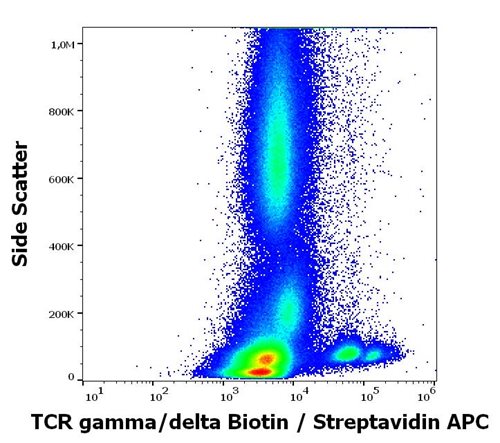Anti-IFN-gamma Monoclonal Antibody (Clone:4S.B3)
Shipping Info:
For estimated delivery dates, please contact us at [email protected]
| Format : | Purified |
| Amount : | 0.1 mg |
| Isotype : | Mouse IgG1 |
| Purification : | Purified by protein-A affinity chromatography |
| Storage condition : | Store at 2-8°C. Do not freeze. |
The Interferon gamma (IFN-gamma; 16-25 kDa) is an important regulator of the immune response, produced in activated Th1 cells and NK cells, particularly in response to IL-2, TNF-alpha and IL-12; its production is suppressed by IL-4, IL-10, and TGF-beta. The producing of IFN-gamma is activated by specific antigens or mitogens through the T cell antigen receptor. IFN-gamma polypeptide forms: 40-60 kDa forms are observable under non-denaturing conditions as dimers and trimers; 20 kDa and 25 kDa forms exist due to variable glycosylation. IFN-gamma belongs to the type II interferons, also called immune IFN. IFN-gamma shows antiviral activity and has important immunoregulatory functions. It is a potent activator of macrophages and had antiproliferative effects on transformed cells. IFN-gamma plays an important role in regulating B cell differentiation by simultaneously stimulating class switch recombination to the IgG3 and IgG2a isotypes while represing class switch recombination to the IgE and IgG1 isotypes. It also appears to promote antigen presentation by B cells through its effects on MHC. Binding of IFN-gamma to its receptor increases the expression of class I MHC on all somatic cells. It also enhances the expression of class II MHC on antigen-presenting cells. IFN-gamma is the major means by which T cells activate macrophages, increasing their ability to kill bacteria, parasites, and tumours. The activation of macrophages by IFN-gamma is essential for the elimination of bacteria that replicate within the phagosomes of macrophages (f.e. Mycobacteria and Listeria monocytogenes). IFN-gamma can potentiate the high antiviral and antitumor effects of the type I interferons (IFN-alpha, IFN-beta). IFN-gamma may also activate neutrophils and NK cells.
Flow Cytometry Application note:intracellular staining
Immunoprecipitation Western Blotting Immunohistochemistry Immunocytochemistry ELISA is being used as detection antibody in combination with capture antibody NIB42 RIA Functional Application Neutralization (weak)
For Research Use Only. Not for use in diagnostic/therapeutics procedures.
| Subcellular location: | Secreted |
| Post transnational modification: | Proteolytic processing produces C-terminal heterogeneity, with proteins ending alternatively at Gly-150, Met-157 or Gly-161. |
| Tissue Specificity: | Released primarily from activated T lymphocytes. |
| BioGrid: | 109680. 5 interactions. |
|
There are currently no product reviews
|






















.png)











